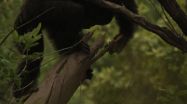(Press-News.org) AMES, Iowa - It was a discovery that changed what researchers knew about the hunting techniques of chimpanzees. In 2007, Jill Pruetz first reported savanna chimps at her research site in Fongoli, Senegal, were using tools to hunt prey. That alone was significant, but what also stood out to Pruetz was the fact that female chimps were the ones predominantly hunting with tools.
It was a point some dismissed or criticized because of the small sample size, but the finding motivated the Iowa State University anthropology professor to learn more. In the years following, Pruetz and her research team have documented more than 300 tool-assisted hunts. Their results, published in the journal Royal Society Open Science, support the initial findings - female chimps hunt with tools more than males.
Generally, adult male chimps are the main hunters and capture prey by hand. Researchers observed both male and female chimps using tools, but more than half of the hunts - 175 compared to 130 - were by females. While males made up about 60 percent of the hunting group, only around 40 percent of the hunts were by males.
"It's just another example of diversity in chimp behavior that we keep finding the longer we study wild chimps," Pruetz said. "It is more the exception than the rule that you'll find some sort of different behavior, even though we've studied chimps extensively."
Both male and female chimps primarily pursued galagos, or bush babies, in tool-assisted hunts. Pruetz says the chimps used a spear-like tool to jab at the animal hiding in tree cavities. She added that one explanation for the sex difference in tool use is that male chimps tended to be more opportunistic.
"What would often happen is the male would be in the vicinity of another chimp hunting with a tool, often a female, and the bush baby was able to escape the female and the male grabbed the bush baby as it fled," Pruetz said.
Why only Fongoli?
The savanna chimps at Fongoli are the only non-human population to consistently hunt prey with tools. Why is that the case? Pruetz, Walvoord Professor of Liberal Arts & Sciences at Iowa State, says a better question may be why are chimps at other sites not using this technique? It may be that they never learned the technique, she said. Tool hunting also may be a result of social tolerance that doesn't exist at other chimp sites.
"At Fongoli, when a female or low-ranking male captures something, they're allowed to keep it and eat it. At other sites, the alpha male or other dominant male will come along and take the prey. So there's little benefit of hunting for females, if another chimp is just going to take their prey item."
The environment is another factor. Pruetz says there are no red colobus monkeys, the preferred prey of chimps at other sites, because of the dry conditions at Fongoli. The bush babies are more prevalent and prey that female chimps can access using tools.
Hunting vs. gathering
Pruetz, a National Geographic Emerging Explorer, is often asked why the female's use of tools is considered hunting rather than gathering. It's a question that reflects stereotypes associated with female chimp behavior. The similarities to termite or ant fishing, which is sometimes used as a comparison for tool-assisted hunting, are superficial, she said. The behavior of the prey and effort required by the hunter is different.
"Fishing for termites is a very different activity than jabbing for a bush baby," Pruetz said. "With fishing, termites grab on to a twig and don't let go and the chimp eats the termites off the twig. When hunting, the bush baby tries to bite, escape or hide from the chimp. The chimps are really averse to being bitten by a bush baby."
While a bush baby is smaller than and not as fierce as a monkey, Pruetz says it is really no different than humans hunting doves instead of deer. Ultimately, the tool-assisted hunting allows female chimps, which may be less likely to run down prey, access to a nutritional food source, Pruetz said.
INFORMATION:
Paco Bertolani, Cambridge University; Mack Shelley, Stacy Lindshield and Kelly Boyer Ontl, Iowa State University; and Erin Wessling, Max Planck Institute for Evolutionary Anthropology, all contributed to this report.
COLUMBUS, Ohio--The unassuming piece of stainless steel mesh in a lab at The Ohio State University doesn't look like a very big deal, but it could make a big difference for future environmental cleanups.
Water passes through the mesh but oil doesn't, thanks to a nearly invisible oil-repelling coating on its surface.
In tests, researchers mixed water with oil and poured the mixture onto the mesh. The water filtered through the mesh to land in a beaker below. The oil collected on top of the mesh, and rolled off easily into a separate beaker when the mesh was tilted.
The ...
The sound, light and temperature levels in paediatric hospital wards often vary, highlighting the lack of consistent environmental standards, according to a new study.
The research is being presented today at the 2015 Sleep and Breathing Conference (16 April, 2015).
Children and parents often suffer sleep deprivation when the environment on a ward is disruptive, which can affect disease recovery and quality of life in hospitalised children. There are no general consistent recommendations covering sound, light and temperature levels to help guide hospitals across ...
Sleep disordered breathing can hamper memory processes in children, according to a new study.
The research, which will be presented today at the Sleep and Breathing Conference (16 April 2015), found that disrupted sleep had an impact on different memory processes and how children learn.
Eszter Csabi led a team of researchers from the University of Szeged and Eötvös Loránd University in Hungary. They analysed 17 children with sleep disordered breathing aged between 6 and 12 years. They looked at different memory processes compared to a control group ...
Imagine having your MRI results sent directly to your phone, with no concern over the security of your private health data. Or knowing your financial information was safe on a server halfway around the world. Or sending highly sensitive business correspondence, without worrying that it would fall into the wrong hands.
Thanks to new research from engineers at the University of Toronto, these types of perfectly secure information exchanges are one step closer to reality. Published this week in Nature Communications, researchers have designed the first all-photonic quantum ...
Children with intellectual disabilities--significantly low cognitive functioning coupled with significant deficits in adaptive or everyday functioning--make up 2 to 3 percent of the population, and it's estimated that 1 in 3 children with disabilities experiences some form of maltreatment. However, in many cases, the disclosures of children with intellectual disabilities aren't investigated or taken to court, in part because of concern over whether these children can describe their experiences sufficiently and be believed by juries. A new study has found that children with ...
Eleven percent of all births worldwide are preterm, or occurring before 37 weeks of pregnancy, and preterm-related causes of death account for a significant number of infant deaths, as well as long-term neurological disabilities. Efforts are under way, including an initiative by the Eunice Kennedy Shriver National Institute of Child Health and Human Development, to reduce elective deliveries before 39 weeks of pregnancy. Now two new longitudinal studies that appear in the journal Child Development offer insights on how to decrease the problems associated with premature ...
Preschoolers and school-age children who are good at identifying what others want, think, and feel are more popular in school than their peers who aren't as socially adept. That's the conclusion of a new meta-analysis--a type of study that looks at the results of many different studies--out of Australia.
The study was done at the University of Queensland, Australia, and appears in the journal Child Development.
"Our study suggests that understanding others' mental perspectives may facilitate the kind of interactions that help children become or remain popular," notes ...
Adolescence is a time of frequent and intense emotional experiences, but some youth handle their emotions better than others. Why do some young people react adaptively while others ruminate? A new study of adolescents shows that youth who mentally take a step back from their own point of view when thinking about something troubling can deal with negative emotions more effectively and become less upset by them.
The study, conducted by researchers at the University of Pennsylvania and the University of Michigan, appears in the journal Child Development.
The researchers ...
In a small study, Johns Hopkins researchers found that DNA from the sperm of men whose children had early signs of autism shows distinct patterns of regulatory tags that could contribute to the condition. A detailed report of their findings will be published online in the International Journal of Epidemiology on April 15.
Autism spectrum disorder (autism) affects one in 68 children in the U.S. Although studies have identified some culprit genes, most cases remain unexplained. But most experts agree that autism is usually inherited, since the condition tends to run in ...
Cincinnati, OH, April 15, 2015 -- Children with autism spectrum disorder (ASD) can develop symptoms before 2 years of age and usually can be diagnosed by 3 years of age; early identification of ASD is associated with improved long-term developmental outcomes. In a new study scheduled for publication in The Journal of Pediatrics, researchers assessed how healthcare providers respond to parents' concerns about their child's early development, as well as how that response affected the timeliness of ASD diagnosis.
Katharine Zuckerman, MD, MPH, and colleagues from Doernbecher ...

